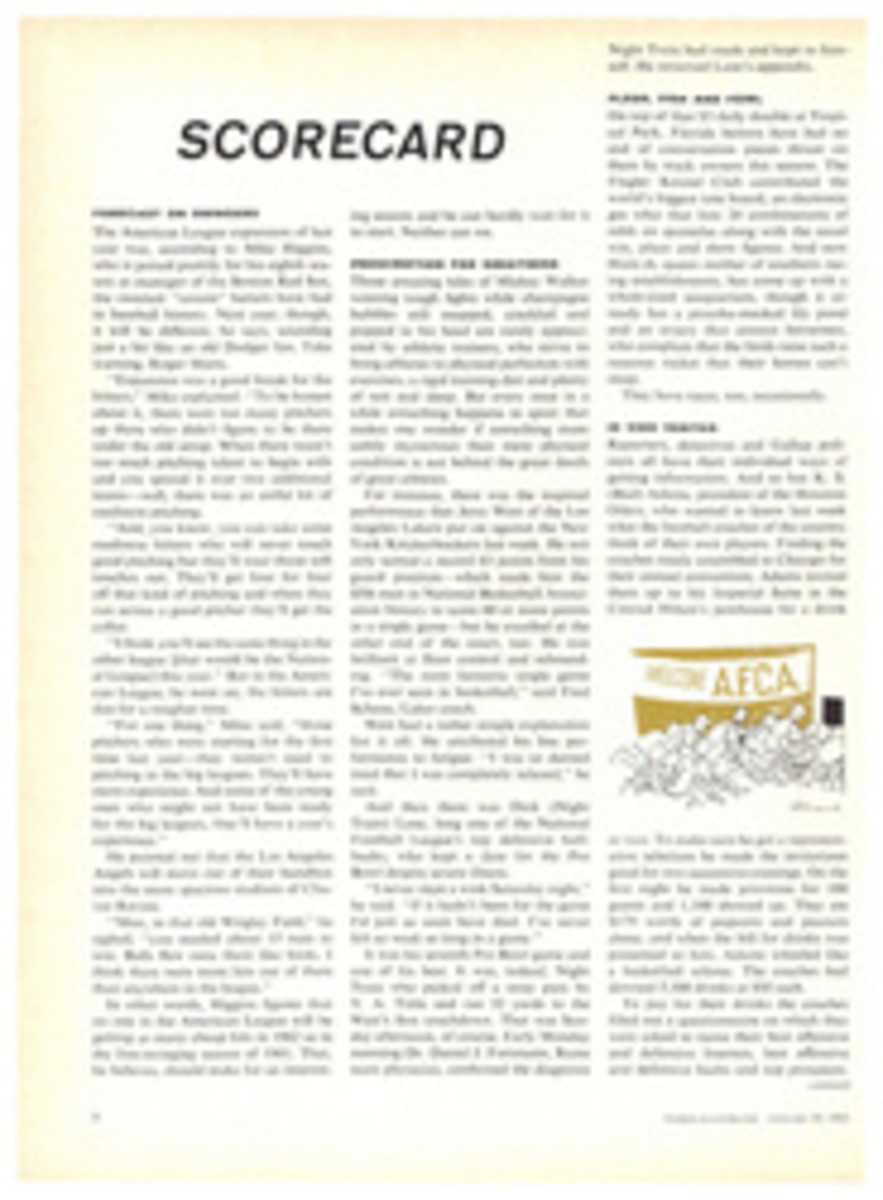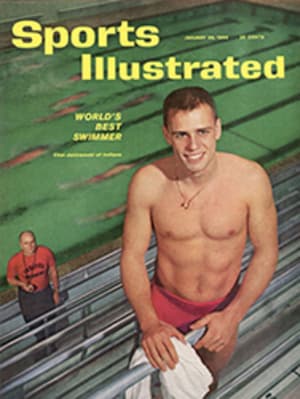
THE CUP GETS AN UNEXPECTED BOOST
The annual dinner of the Boston Yacht Club usually is a pretty staid affair. But two weeks ago the diners—and the rest of the sailing world—were stirred by an announcement that completely changed the complexion of the world's premier yacht race, the America's Cup. In his farewell speech retiring Commodore Evan Ross Anderson revealed that he and a group of associates had begun building a new 12-meter yacht as a potential defender against the Australian challenge at Newport next September.
Until that moment the summer-long trials threatened to be a parade of three known quantities—Columbia, Weatherly and Easterner—all left over from the 1958 trials, with selection a sail-over for the former defender, Columbia. For the first time in the hundred-year history of the cup, no new vessel was being built in response to an overseas invasion, and it seemed that time had run out. Roderick Stephens had called July the "latest safe date for an order," based on the 1958 building schedule of Columbia.
The press of time bothers this new group not one whit, a fact that perhaps serves as an index to its character, which shows no trace of Bostonian conservatism. At 67 Ross Anderson is a dynamic individualist who has built a complex of engineering, electronics and management consultant companies. To him the unorthodox method is only another way of getting a job done. "What is conventional?" is Anderson's favorite answer to questions involving anything from manufacturing procedure to the hull of a 12-meter. And indeed in the long history of the cup there have been few more unusual approaches to the job of creating a defender.
The 12-meter project began last summer with Anderson's Lord Jim, a 72-foot gaff-rigged schooner. In her, he had been content to poke lazily in and out of New England harbors until suddenly he got the urge to race the old boat—perhaps because of the presence aboard Lord Jim of 29-year-old John J. (Don) McNamara Jr., a small-boat racer of considerable skill and success. In an effort to make Lord Jim go faster, McNamara enlisted his friend and sailing companion, Ted Hood of Marblehead, who fashioned a new aluminum foremast, hanging thereon a weird collection of sails. Entered in the Marblehead-Halifax ocean race, with McNamara as guest skipper, Lord Jim astounded competitors by finishing first in fleet.
During the ensuing celebration Anderson is reported to have asked his crew "What do we do next?" and to have got the reply "Why not build a 12 for the America's Cup?" Anderson declines to confirm or deny this story, pointing out that quite a few champagne bottles dotted the wake after Lord Jim crossed the line. But he concedes a growing interest in a possible defender from that time on. "We kept hearing rumors of other boats. If someone else had definitely come forward, we probably would have dropped out. But we decided to go ahead with preliminary designs."
According to Anderson, Ted Hood of Marblehead and Ray Hunt of Tilton, N.H. were both invited to produce models, whose merits would be compared in a towing tank. Hood was ready first with two basic designs, and Hunt withdrew, later conducting his own tests with satisfactory but undisclosed results. Tank testing of the Hood hulls began in mid-October, and these tests were quite unlike anything that the experimental towing tank at Stevens Institute in Hoboken, N.J., had ever seen. Most designers deliver line blueprints, from which Stevens constructs wooden models for testing. Hood bypassed all this and showed up at Hoboken one day with finished models under his arm, wrapped in a sail bag.
After each testing session, Ted collected his data and flew back to Marblehead. Five tries later, one model was abandoned, and it was decided to concentrate on the other. Ted kept commuting back and forth. "I would take it down and test at night, fly back, work on it in the shop for a day or maybe a couple of days, even varnishing at home, then test again." Part of the reason for the night testing was that a British syndicate had reserved the tank during the day. (The British are engaged in prelim-nary experiments which they hope will produce a suitable boat for a challenge in 1963.)
Around Christmas the meticulous Hood was satisfied. "He telephoned and said, 'I've got a boat,' " recalls Anderson. "That was enough for me. I said, 'Fine. We'll go ahead.' " Anderson was joined in the underwriting of costs by Investment Banker Robert W. Purcell of Watertown, N.Y., a longtime friend and owner of a 34-foot cruising sloop. Graves Yacht Yard in Marblehead was told to go ahead, and Robert L. Williams, a top executive in the Anderson organization, was assigned the job of coordinator and expediter. Already materials are flowing into the Graves plant. An important member of the organization will be Ted's father, Stedman Hood, a retired engineer who, because of his practical wizardry and grasp of obscure theories, is called The Professor. In the background in 1958 as a contributing expert for the 12-meter Vim during that gallant old boat's near miss at becoming the cup defender, the elder Hood will be very much a factor in Anderson's campaign this summer. These are some of the reasons for confidence in a May launching schedule.
Another reason is Frederick E. Hood himself. At 34, he possesses a range of talents without parallel in yachting.
Born in Beverly, Mass., Ted's entire life has been boats. "He was never anywhere but on the water as a kid," says his father. Ted's formal training in engineering consisted of two years at Wentworth Institute in Boston, where he studied "house construction, not boats."
In 1950, to help his own racing, he began making sails, and was so successful that he found himself in the business. Two years later, unable to buy synthetic fabric that satisfied him, he began the complicated task of processing cloth and was soon producing fabric so superior that competitors acknowledged it as a major factor in the triumphant performance of Hood sails. In 1954 he expanded into the boat repair and construction field by organizing the Little Harbor Boat Yard. The following year he designed his first boat, a 40-foot centerboard sloop called Robin, which used Finisterre as a departure point. Since then he has designed or built four other Robins, all highly successful, combining speed, seaworthiness and comfort—but none has even remotely resembled in type or philosophy the ultimate in modern racing machines, a 12-meter.
Virtually every element for the yet-unnamed New England entry is being produced on a 400-yard strip of Marblehead waterfront. The basic design and tank models were made in Hood's own shop under his direction. He was assisted by Britton Chance Jr. and Kenneth C. Smalley. Soon Dacron and nylon fabric will be processed, and in the adjoining loft will be cut and sewed into mainsails, jibs and spinnakers. In another Hood shed the aluminum mast and boom will be fabricated, running rigging made and standing rigging fitted. Of the major components, only the hull is being built off the Hood property, and that at Graves, virtually next door, and easy for Ted to inspect at any hour. Not since the days of another great yachting talent, Nathanael Herreshoff, designer of five cup defenders, has one man had so much to do with the production of a cup candidate.
After launching, Hood will occupy an equally important role as coskipper with McNamara. For in addition to his other extraordinary talents, Ted is a master helmsman, tactician and deck coordinator. In 1956 he won the Mallory Cup, emblematic of the North American men's sailing championship. Two years later off Newport, he was aboard Vim not only as sailmaker but trimmer. Since then, turning to ocean racers of his own design, Hood has been victor in events from Nassau to Halifax. Only two weeks ago he took a short weekend vacation from 12-metering to slam the brand-new Robin across the Gulf Stream to first place in the Miami to Cat Cay race.
Ted Hood is as silent as a Yankee is supposed to be. Consequently outsiders will find out even less about his new boat than is generally divulged by builders of cup defenders. "There are enough things we have done differently that might make her good or bad," says Ted. "We presume they are going to make her better, although under the rule it is probably impossible to make any 12 that will be a superboat compared to the others."
However, with Hood's backlog of knowledge about 12-meter sails (of the 50-odd he has made since 1958, a good number are aboard Columbia, Weatherly, Easterner and the Australian challenger), hulls and racing techniques, his competitors can take no comfort from any hints that he has not found a breakthrough hull.
So far, only Hood and McNamara have been named to the crew, and no division of duties has yet been worked out between the two. "It probably will be a matter of who can be most useful where at the moment," says Don McNamara. "Ted and I have sailed so much together that each trusts the other to be his eyes. The man at the wheel must be free to concentrate on steering. Nobody can be a tactician and a go-fast guy at the same time."
The road to selection as defender of the America's Cup is long and hard, and no one can yet risk a prediction. But the immediate effect of Anderson's announcement is to make the next summer of 12-meter racing look very exciting after all.
PHOTO
KEY MEN IN CUP SYNDICATE, Industrialist E. Ross Anderson (left), Designer Ted Hood (center) and racing enthusiast Don McNamara, go over list of equipment for new 12-meter.

